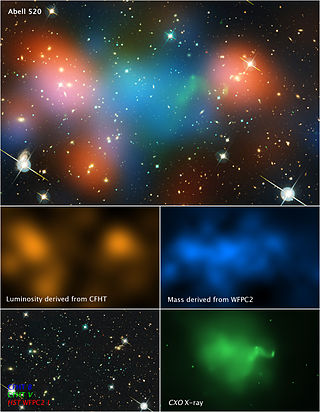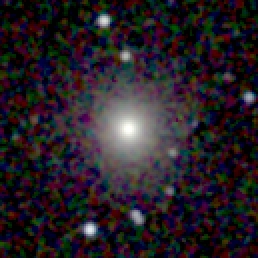
Abell 2218 is a large cluster of galaxies over 2 billion light-years away in the constellation Draco.

The Norma Cluster (ACO 3627 or Abell 3627) is a rich cluster of galaxies located near the center of the Great Attractor; it is about 68 Mpc (222 Mly) distant. Although it is both nearby and bright, it is difficult to observe because it is located in the Zone of Avoidance, a region near the plane of the Milky Way. Consequently, the cluster is severely obscured by interstellar dust at optical wavelengths. Its mass is estimated to be on the order of 1015 solar masses.

The Coma Cluster is a large cluster of galaxies that contains over 1,000 identified galaxies. Along with the Leo Cluster, it is one of the two major clusters comprising the Coma Supercluster. It is located in and takes its name from the constellation Coma Berenices.

The Perseus cluster is a cluster of galaxies in the constellation Perseus. It has a recession speed of 5,366 km/s and a diameter of 863′. It is one of the most massive objects in the known universe, containing thousands of galaxies immersed in a vast cloud of multimillion-degree gas.

Abell 400 is a galaxy cluster which contains the galaxy NGC 1128 with two supermassive black holes spiraling towards merger.

The Comet Galaxy, a spiral galaxy located 3.2 billion light-years from Earth, in the galaxy cluster Abell 2667, was found with the Hubble Space Telescope. This galaxy has slightly more mass than our Milky Way. It was detected on 2 March 2007.

The Hercules Cluster is a cluster of about 200 galaxies some 500 million light-years distant in the constellation Hercules. It is rich in spiral galaxies and shows many interacting galaxies. The cluster is part of the larger Hercules Supercluster, which is itself part of the much larger Great Wall super-structure.

Abell 520 is a galaxy cluster in the Orion constellation, located at a co-moving radial distance of 811 Mpc (2,645 Mly) and subtends 25 arcminutes on the Earth sky.

The Leo Cluster is a galaxy cluster about 330 million light-years distant in the constellation Leo, with at least 70 major galaxies. The galaxy known as NGC 3842 is the brightest member of this cluster. Along with the Coma Cluster, it is one of the two major clusters comprising the Coma Supercluster, which in turn is part of the CfA2 Great Wall, which is hundreds of millions light years long and is one of the largest known structures in the universe.

Abell 370 is a galaxy cluster located nearly 5 billion light-years away from the Earth, in the constellation Cetus. Its core is made up of several hundred galaxies. It was catalogued by George Abell, and is the most distant of the clusters he catalogued.

Abell 2163 is one of the richest and most distant of the clusters of galaxies found in the Abell catalogue. Its abell richness class is 2 and position is at a redshift z=0.2. Data from Chandra X-ray Observatory have shown that it is the hottest galaxy cluster in the Abell catalogue. It is also a merging cluster.

Abell 2744, nicknamed Pandora's Cluster, is a giant galaxy cluster resulting from the simultaneous pile-up of at least four separate, smaller galaxy clusters that took place over a span of 350 million years, and is located approximately 4 billion light years from Earth. The galaxies in the cluster make up less than five percent of its mass. The gas is so hot that it shines only in X-rays. Dark matter makes up around 75 percent of the cluster's mass.

Abell 2199 is a galaxy cluster in the Abell catalogue featuring the brightest cluster galaxy NGC 6166, a cD galaxy. Abell 2199 is the definition of a Bautz-Morgan type I cluster due to NGC 6166.

Abell 383 is a galaxy cluster in the Abell catalogue.

Abell 1413 is a massive and rich type I galaxy cluster straddling the border between the constellations Leo and Coma Berenices, with the projected comoving distance of approximately 640 Mpc (2.1 billion ly). The cluster is especially notable due to the presence of its very large brightest cluster galaxy (BCG), one of the most extreme examples of its type, as well as one of the largest galaxies known. The cluster was first noted by George O. Abell in 1958.
Abell 1795 is a galaxy cluster in the Abell catalogue.

Abell 2390 is a galaxy cluster in the Abell catalogue.
Abell 222 is a galaxy cluster in the constellation of Cetus. It holds thousands of galaxies together. It is located at a distance of 2.4 billion light-years from Earth.

NGC 759 is an elliptical galaxy located 230 million light-years away in the constellation Andromeda. NGC 759 was discovered by astronomer by Heinrich d'Arrest on September 17, 1865. It is a member of Abell 262.

Abell 68 is massive and rich galaxy cluster located in the constellation of Pisces with a projected co-moving distance of approximately 1124.6 Mpc or 3.668 billion light-years away from Earth. The cluster is especially notable for its gravitational lensing and was first discovered by George O. Abell in 1958.



















